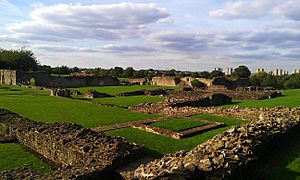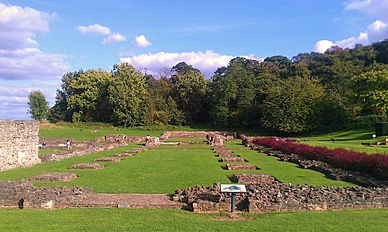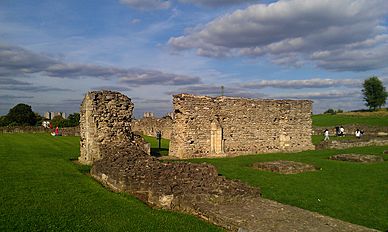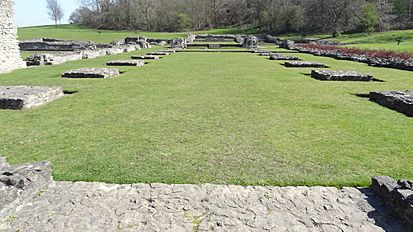Lesnes Abbey facts for kids
Lesnes Abbey is an old monastery that is now a ruin. It is located in Abbey Wood, in the London Borough of Bexley, southeast London, England. This historic site is protected as a scheduled monument. Its ruins are also listed as Grade II by Historic England, meaning they are very important.
Right next to the abbey are the Lesnes Abbey Woods. These woods are a special Local Nature Reserve. Part of the woods is called the Abbey Wood SSSI, which is a geological Site of Special Scientific Interest. This area is super important for finding really old fossils from the early Tertiary period.
Contents
History of Lesnes Abbey
How Lesnes Abbey Began
After the Norman Conquest in 1066, the land around Lesnes, near Erith, became owned by Bishop Odo. The area was even mentioned in the Domesday Survey as Loisnes.
Lesnes Abbey, also known as the Abbey of St Mary and St Thomas the Martyr, was started in 1178. It was founded by Richard de Luci, who was a very important judge in England at the time. Some people think he founded the abbey to make up for his part in the murder of Thomas Becket. In 1179, de Luci stopped being a judge and moved into the abbey. He passed away just three months later and was buried there.
The abbey is located in what is now a busy part of southeast London. It sits at the northern edge of the Lesnes Abbey Woods. The land here rises above what used to be marshland.
The Peasants' Revolt and the Abbey
In 1381, a local leader named Abel Ker from Erith led a rebellion. This was part of the famous Peasants' Revolt, which started in Essex. A group of rebels from Erith stormed into Lesnes Abbey. They made the abbot (the head of the monastery) promise to support their cause. After that, they marched to Maidstone to join the main group led by Wat Tyler.
Challenges and Closure of the Abbey
The Abbott of Lesnes Abbey was a powerful local landowner. He played a big part in draining the marshy land nearby. However, keeping the land dry and maintaining the river banks cost a lot of money. This was one of the main reasons why the abbey always struggled financially.
Lesnes Abbey never grew into a very large community. It was eventually closed down in 1525 by Cardinal Wolsey. He had permission to close monasteries that had fewer than seven monks. This made Lesnes Abbey one of the first monasteries to close during the time of the Dissolution of the Monasteries in 1534.
After it closed, most of the abbey buildings were torn down. Only the Abbott's Lodging (the abbot's house) remained. Henry Cooke bought the site in 1541. Later, Sir John Hippersley took building materials from the site. He then sold the property to Thomas Hawes in 1632. In 1633, it was given to Christ's Hospital. Some of the stone from the abbey is believed to have been used to build Hall Place in nearby Bexley.
Rediscovering the Abbey
For a long time, the abbey was mostly forgotten and the area became farmland. The abbot's house was used as part of a farmhouse. Today, the site has been restored. You can see some of the original walls and the full outline of the abbey. This helps visitors imagine how big and grand it once was.
The abbey is part of the Green Chain Walk, a path for walking. It is surrounded by parkland and a beautiful ornamental garden. There is also a cafe, a small exhibition about the abbey, and restrooms for visitors.
You can also find a large mulberry tree (Morus nigra) on the northern side of the abbey. Its branches are supported from below.
Archaeological Finds and Public Access
The site was dug up by the Woolwich & District Antiquarian Society around 1909 to 1910. Some of the things they found are now on display at the Greenwich Heritage Centre in Woolwich. Other finds are in the museum at Erith Library. A special book from the abbey, called the "Missale de Lesnes," is kept at the library of the Victoria & Albert Museum in South Kensington, London.
The former London County Council bought the ruins in 1930. They opened the site to the public as a park in 1931. Since 1986, the London Borough of Bexley has owned the site. A path from the Green Chain Walk goes past the ruins on its way from Oxleas Wood to the Thamesmead riverside.
Important Burials at Lesnes Abbey
- Richard de Luci, the founder of the abbey, was buried here on July 14, 1179.
Lesnes Abbey Ward
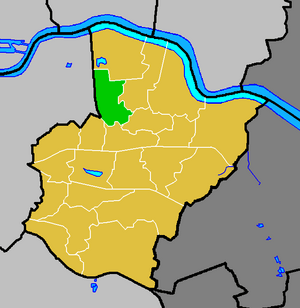
Today, Lesnes Abbey gives its name to one of the 21 electoral wards in the London Borough of Bexley. The abbey ruins are located in the northern part of the Lesnes Abbey ward.
Woolwich Road, which is the A206 road, runs through the middle of the ward from east to west. The A2041 road goes from north to south and forms the western edge of the ward. West Heath is also located within this ward, south of Woolwich Road.
The Lesnes Abbey ward is about 2.5 kilometers (1.5 miles) long from north to south at its longest point. It is a little less than 1.5 kilometers (0.9 miles) wide from east to west at its widest point. In 2011, the population of the ward was 11,346 people.
Gallery
Images for kids


